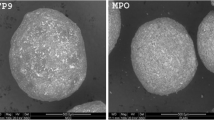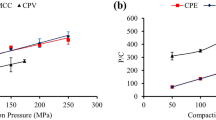Abstract
Introduction
Microcrystalline cellulose (MCC) is the commonly used pelletization aid in wet extrusion-spheronization processes. MCC has the structure of cellulose I and is denoted as MCC I. Recently, MCC II, a different polymorphic type of MCC, became commercially available, known under the name MCC SANAQ®burst. Due to the fact, that MCC II can be used as a filler and a disintegrant in tableting, MCC SANAQ®burst was investigated as new pelletization aid with the goal to prepare disintegrating pellets.
Materials
MCC II pellets were compared to the corresponding conventional pellets, manufactured on the basis of MCC I, namely Avicel® PH 102. Formulations with 10%, 20%, and 50% of either MCC I or MCC II as pelletization aids were produced.
Methods
One series of binary mixtures, contained lactose monohydrate as filler and a second series chloramphenicol as model drug. All pellets were characterized by their yield, aspect ratio, equivalent diameter, water content, tensile strength, disintegration behavior and—if applicable—drug release.
Results and Discussion
The production of pellets with sufficient quality properties by addition of 10%, 20%, and 50% of MCC II as pelletization aid was possible. In contrast to MCC I pellets, MCC II-based pellets showed disintegration resulting in a much faster drug release.
Conclusion
MCC SANAQ®burst is a promising pelletization aid providing disintegrating and fast-dissolving pellets.








Similar content being viewed by others
References
Thommes M, Kleinebudde P. Use of κ-carrageenan as alternative pelletisation aid to microcrystalline cellulose in extrusion/spheronisation. I. Influence of type and fraction of filler. Eur J Pharm Biopharm. 2006;63:59–67.
Okada S, Nakahara H, Isaka H. Adsorption of drugs on microcrystalline cellulose suspended in aqueous solutions. Chem Pham Bull. 1987;35:761–8.
Bornhöft M, Thommes M, Kleinebudde P. Preliminary assessment of carrageenan as excipient for extrusion/spheronisation. Eur J Pharm Biopharm. 2005;59:127–31.
Tho I, Sande SA, Kleinebudde P. Pectinic acid, a novel excipient for production of pellets by extrusion/spheronisation: preliminary studies. Eur J Pharm Biopharm. 2002;54:95–9.
Liew CV, Gu L, Soh JLP, Heng PWS. Functionality of cross-linked polyvinylpyrrolidone as a spheronisation aid: a promising alternative to microcrystalline cellulose. Pharm Res. 2005;22(8):1387–98.
Dukic´-Ott A, Thommes M, Remon JP, Kleinebudde P, Vervaet C. Production of pellets via extrusion—spheronisation without the incorporation of microcrystalline cellulose: a critical review. Eur J Pharm Biopharm 2009; 71 (1) 38–46.
Kumar V, Reus-Medina M, Yang D. Preparation, characterization, and tabletting properties of a new cellulose-based pharmaceutical aid. Int J Pharm. 2002;235:129–40.
Reus-Medina M, Lanz M, Kumar V, Leuenberger H. Comparative evaluation of the powder properties and compression behavior of a new cellulose-based direct compression excipient and Avicel PH-102. J Pharm Pharmacol. 2004;56:951–6.
Lanz M, Pharmaceutical powder technology: towards a science based understanding of the behavior of powder systems, Dissertation, University of Basel, 2006.
Phadnis NV, Suryanarayanan R. Polymorphism in anhydrous theophylline—implications on the dissolution rate of theophylline tablet. J Pharm Sci. 1997;86:1256–63.
Chemburkar SR, Bauer J, Deming K, Spiwek H, Patel K, Morris J, et al. Dealing with the impact of ritonavir polymorphs on the late stages of bulk drug process development. Org Process Res Dev. 2000;4:413–17.
Listionhadi Y, Hourigan JA, Sleigh RW, Stelle RJ. Moisture sorption, compressibility and caking of lactose polymorphs. Int J Pharm. 2008;359:123–34.
Burger A, Henck JO, Hetz S, Rollinger JM, Weissnicht AA, Stottner H. Energy/temperature diagram and compression behavior of the polymorphs of D-mannitol. J Pharm Sci. 2000;89:457–68.
Kono H, Numata Y, Erate T, Takai M. 13C and 1H resonance assignment of mercerized cellulose II by two-dimensional MAS NMR spectroscopies. Macromolecules. 2004;37:5310–16.
Kroon-Batenburg LMJ, Kroon J. The crystal and molecular structures of cellulose I and II. Glycoconj J. 1997;14:677–90.
El-Sabawi D, Price R, Edge S. Novel temperature controlled surface dissolution of excipient particles for carrier based dry powder inhaler formulations. Drug Dev Ind Pharm. 2006;32:243–51.
Merck Index “Different Monographs” in: The Merck Index—an Encyclopedia of Chemicals, Drugs and Biologicals; Merck & Co Rahway, NJ, USA 1989.
Sanderson H, Thomsen M. Comparative analysis of pharmaceuticals versus industrial chemicals acute aquatic toxicity classification according to the United Nations classification system for chemicals. Assessment of the (Q)SAR predictability of pharmaceuticals acute aquatic toxicity and their predominant acute toxic mode-of-action. Toxicol Lett. 2009;187:84–93.
Shipway PH, Hutchings IM. Fracture of brittle spheres under compression and impact loading I. Elastic stress distributions. Philos Mag A. 1993;67:1389–404.
Schröder M, Kleinebudde P. Structure of disintegrating pellets with regard to fractal geometry. Pharm Res. 1995;12(11):1694–700.
Langguth P, Fricker G, Wunderli-Allenspach H. Biopharmazie. Weinheim: Wiley; 2004.
Korsmeyer RW, Peppas NA. Effect of the morphology of hydrophilic polymeric matrices on the diffusion and release of water soluble drugs. J Memb Sci. 1981;9:211–27.
Höpner T, Jayme G, Ulrich JC. Bestimmung des Wasserrückhaltevermögens (Quellwertes) von Zellstoffen. Das Papier. 1955;19/20:476–82.
Thommes M, Ely DR, Kleinebudde P. The water binding behaviour of κ-Carrageenan determined by three different methods. Pharm Dev Tech. 2009;14(3):249–58.
Brittain HG, Lewen G, Newman AW, Fiorelli K, Bogdanowich S. Changes in material properties accompanying the national formulary (NF) identity test for microcrystalline cellulose. Pharm Res. 1993;10(1):61–7.
Kleinebudde P. Shrinking and swelling properties of pellets containing microcrystalline cellulose and low substituted hydroxypropylcellulose: I. shrinking properties. Int J Pharm. 1994;109:209–19.
Reynolds AD. A new technique for the production of spherical particles. Manuf Chemist. 1970;41:40–3.
Kleinebudde P. The crystallite-gel-model for microcrystalline cellulose in wet-granulation, extrusion, and spheronisation. Pharm Res. 1997;14(6):804–9.
Krässig HA. Cellulose: structure, accessibility and reactivity. Yverdon: Gordon and Breach Science Publisher; 1993.
Cambridge Structural Database (CSD), The Cambridge Crystallographic Data Centre; 12 Union Road, Cambridge, UK.
Nishiyama Y, Langan P, Chanzy H. Crystal structure and hydrogen-bonding system in cellulose Iβ from synchrotron X-ray and neutron fiber diffraction. J Am Chem Soc. 2002;124(31):9074–82.
Nishiyama Y, Sugiyama J, Chanzy H, Langan P. Crystal structure and hydogen bonding system in cellulose Iα from synchrotron X-ray and neutron fiber diffraction. J Am Chem Soc. 2003;125(47):14300–6.
Zimm KR, Schwartz JB, O’Connor RE. Drug release from a multiparticulate pellet system. Pharm Dev Techn. 1995;1:37–42.
O’Connor RE, Schwartz JB. Drug release mechanism from a microcrystalline cellulose pellet system. Pharm Res. 1993;10(3):356–61.
Nishiyama Y. Structure and properties of the cellulose microfibril. J Wood Sci 2009 (in press).
Langan P, Nishiyama Y, Chanzy H. A revised structure and hydrogen-bonding system in cellulose II from a neutron fiber diffraction analysis. J Am Chem Soc. 1999;121:9940–6.
Acknowledgment
The authors acknowledge the financial support and the gift of MCC SANAQ®burst from Pharmatrans SANAQ Ltd, Basel, Switzerland. Furthermore, the authors are grateful to SciConcept for their support regarding crystal structure analyses.
Author information
Authors and Affiliations
Corresponding author
Rights and permissions
About this article
Cite this article
Krueger, C., Thommes, M. & Kleinebudde, P. “MCC SANAQ®burst”—A New Type of Cellulose and its Suitability to Prepare Fast Disintegrating Pellets. J Pharm Innov 5, 45–57 (2010). https://doi.org/10.1007/s12247-010-9080-4
Published:
Issue Date:
DOI: https://doi.org/10.1007/s12247-010-9080-4




